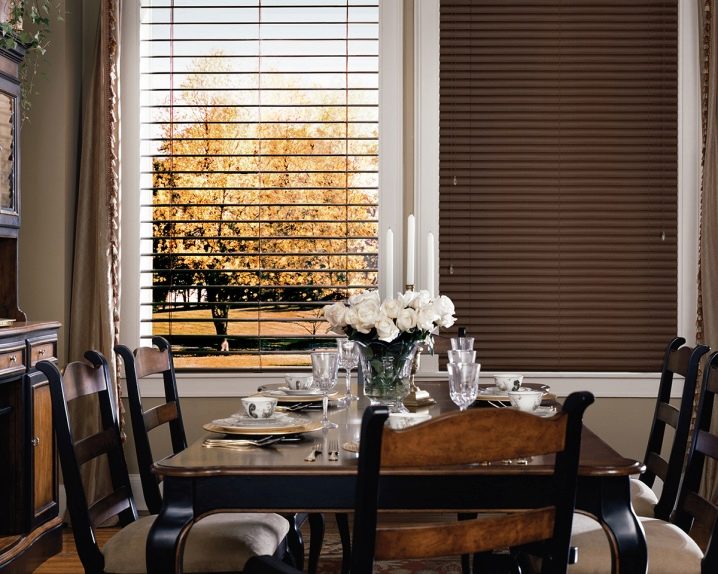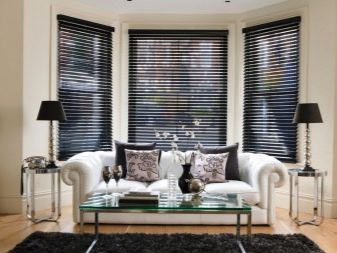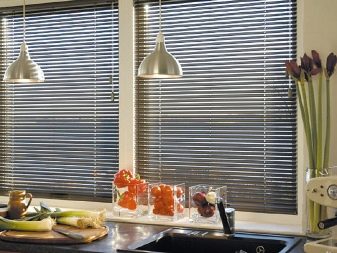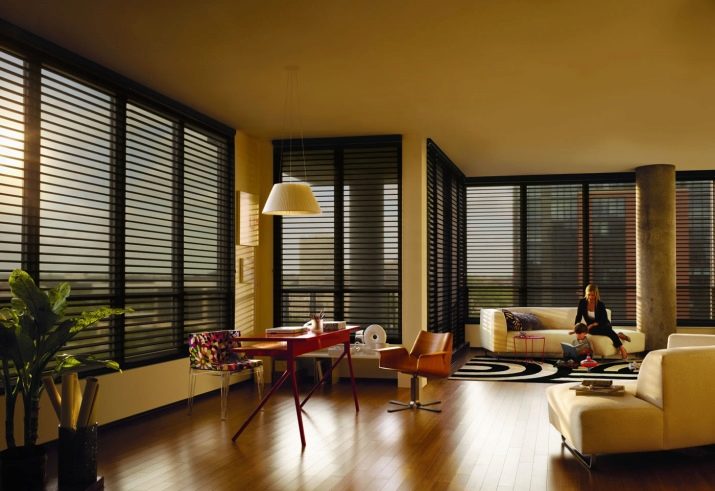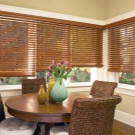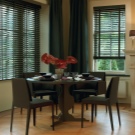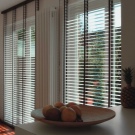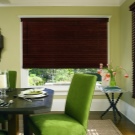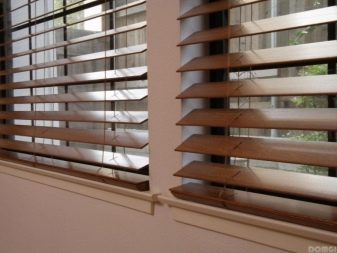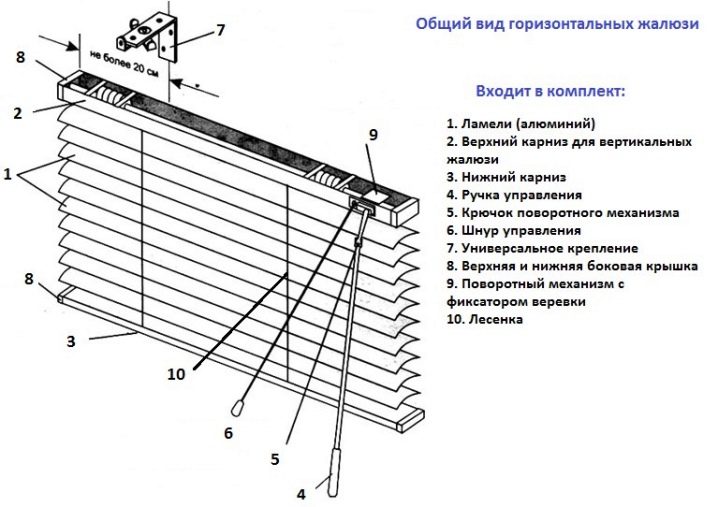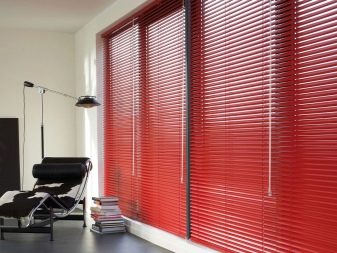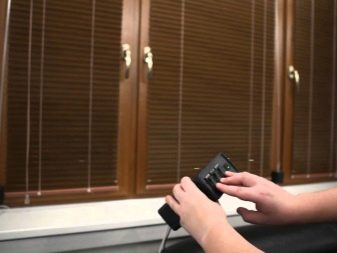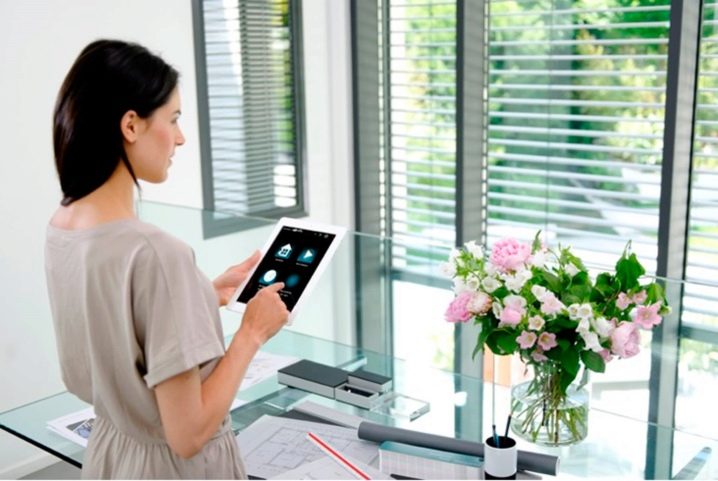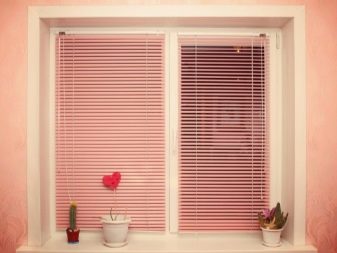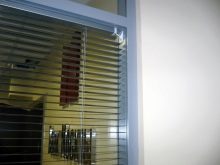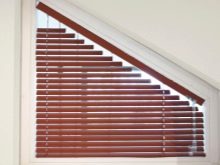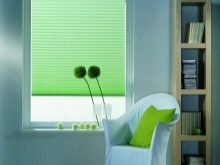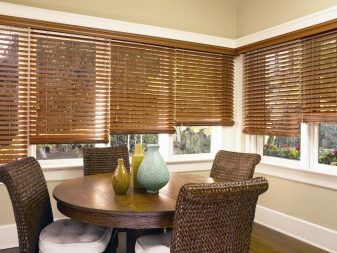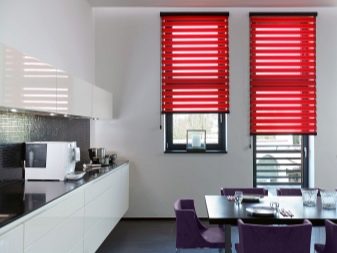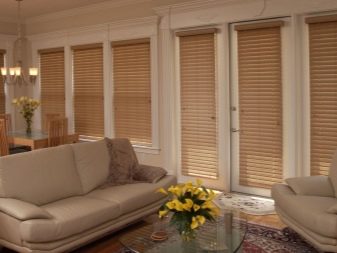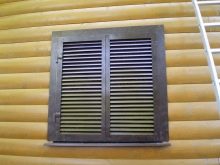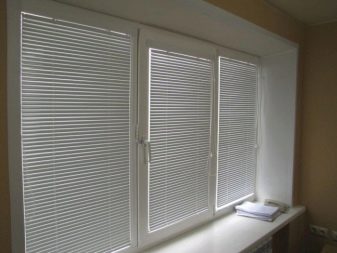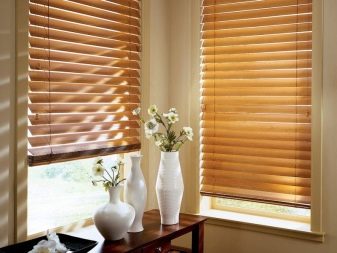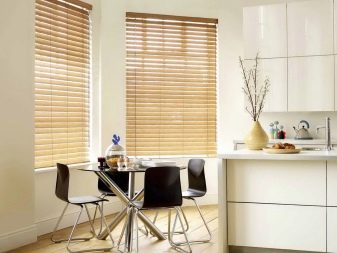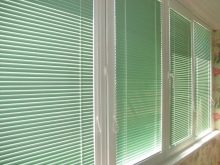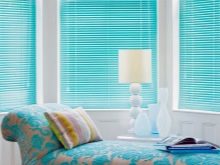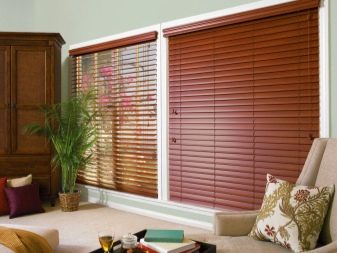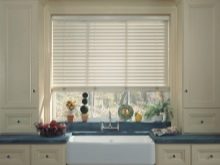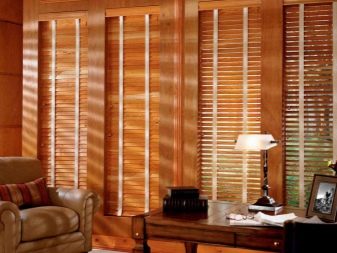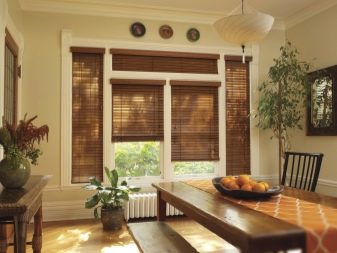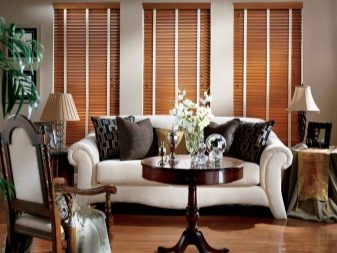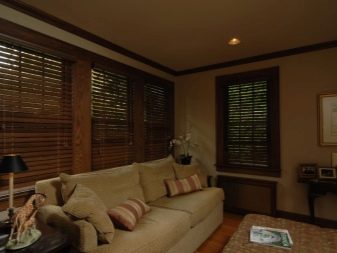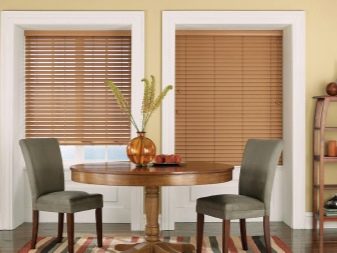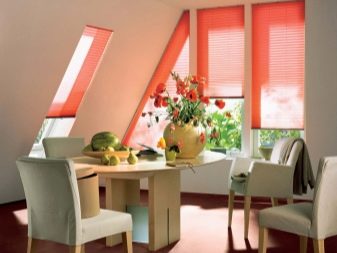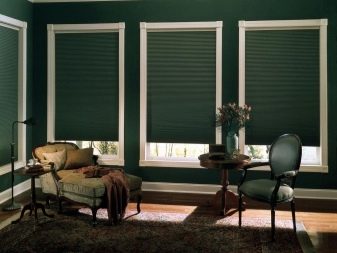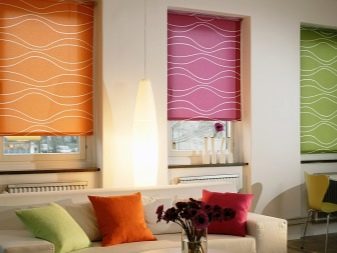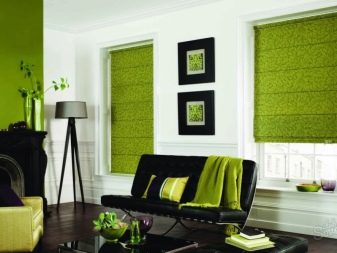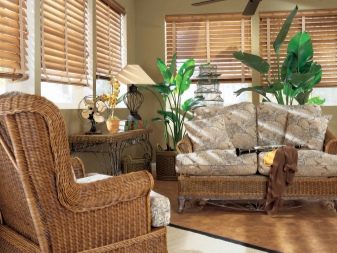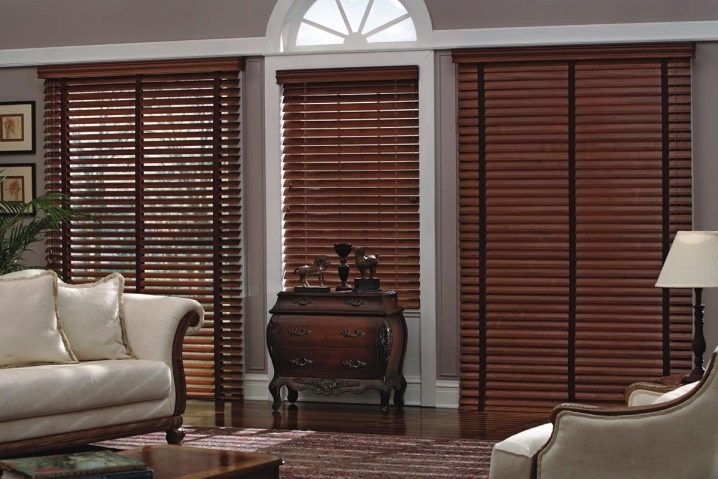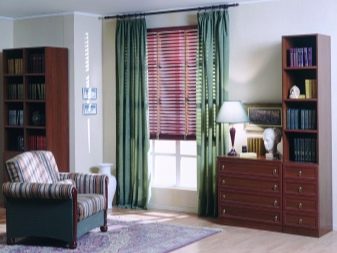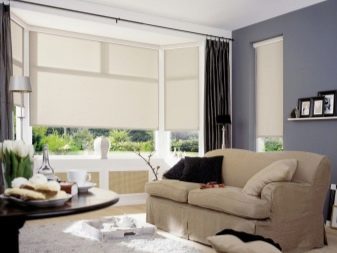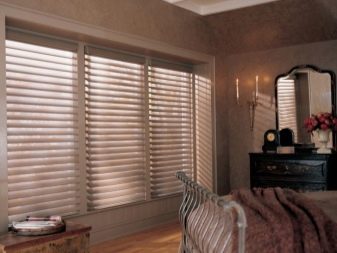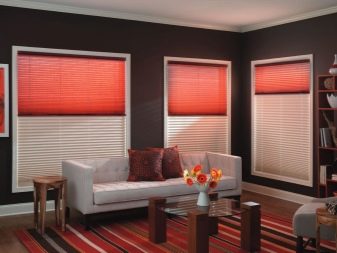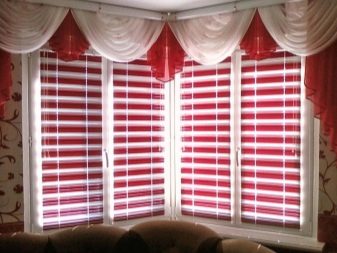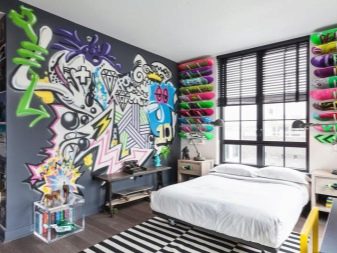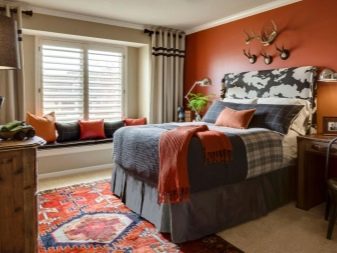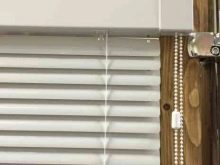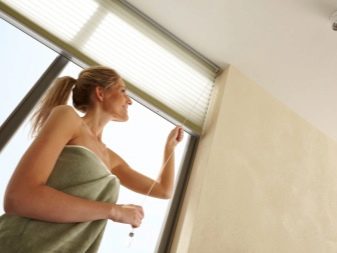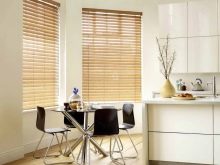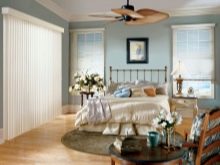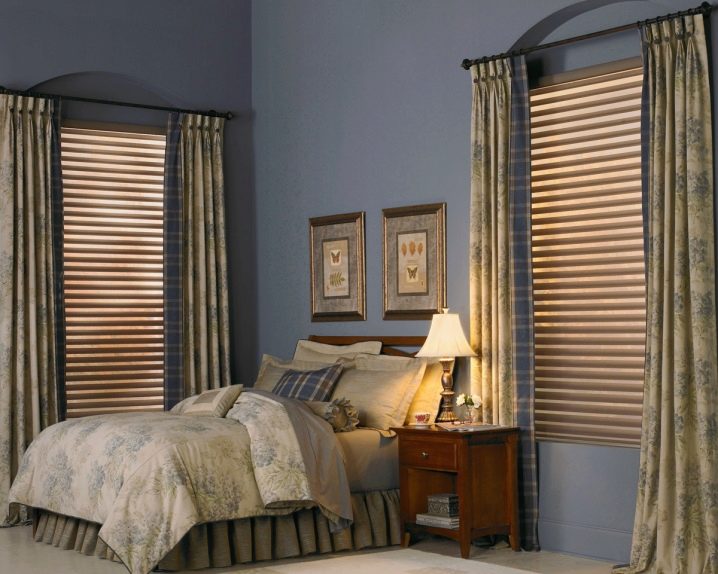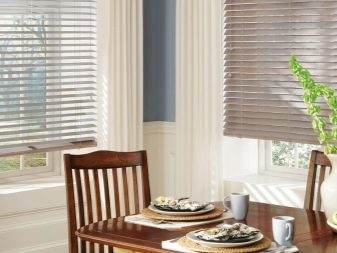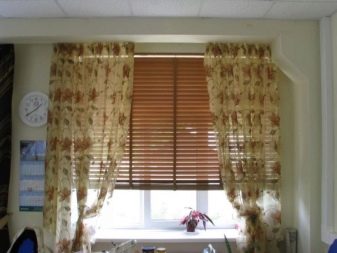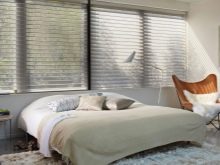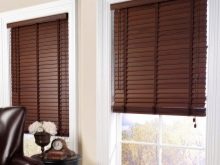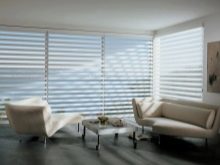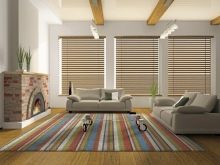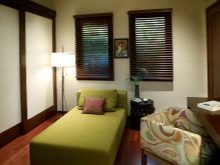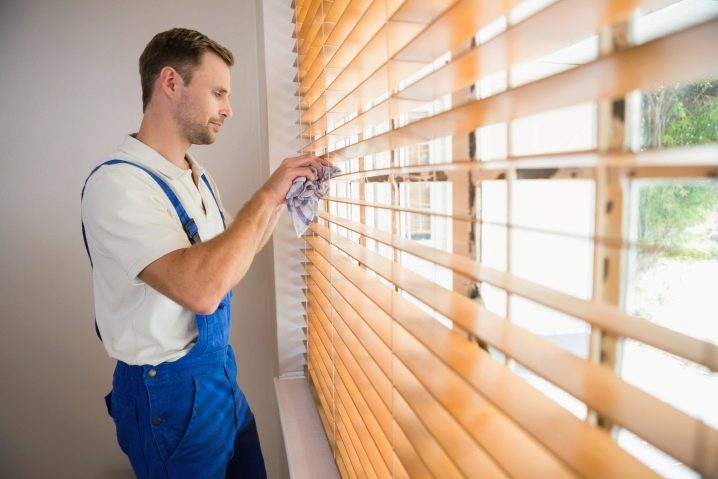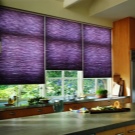Horizontal blinds
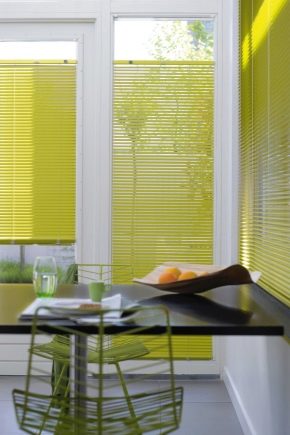
For a relatively short period of time, blinds completely changed the idea of yourself as an attribute of boring office life, becoming a bright and stylish accessory that is used in the construction of residential facilities. Individual attention should be paid to horizontal blinds - effective light-shielding systems for window space design.
What it is?
Horizontal blinds are lifting curtains with a horizontal type of connection and the location of the lifting shutters. Light shielding systems of this type are subdivided into subspecies by several criteria: material for the manufacture of lamellae, purpose, principle of control, method of attachment.
The advantages of window blinds
Regardless of the type of horizontal window blinds, such products have a lot of advantages:
- Save space and have a small weight.
- Functional: protects from the bright sun and reflect the flow of sunlight.
- Versatile in use - optimally suited for the organization of window openings of almost any size.
- Understandable and reliable in management, unpretentious in service.
- Installation requires a minimum of space, installation is extremely simple, repair is trouble-free.
A wide range of products and a wide choice of colors allows you to choose a light protective product that will not contradict most of the popular styles of interior design.
Mechanism and design
The control mechanism of horizontal sun protection systems is characterized by multifunctionality, due to the wide possibilities of adjusting the degree of illumination of the room. The volume of the light flux can be changed due to the formation of the desired angle of the lamellae, raising the plates to the required level and the ability of the system to fully open the window.
System device:
- Located on top of the case with a swivel axis, rollers, upper eaves, brackets,control cord, magnetic lock rope, turning mechanism, the top cover.
- In the middle part there are lamellae (wooden, plastic, aluminum) - horizontal plates of the same size, a ladder - a string for connecting lamellae and a plug.
- The bottom eaves are provided below, bounding the lamella canvas and the side cover.
To increase the comfort of use and improve the aesthetic properties, the structures are additionally equipped with various parts - ergonomic handles, valance - with overlays on the upper bar.
Kinds
To better navigate the choice of horizontal blinds, find out the features of the main types of lighting systems.
Depending on the type of control, the products are:
- Hand operatedwhere the angle of inclination of the plates is regulated by ropes and a rotating handle.
- With electric drive. Here the models have electric motors that are responsible for the operation of the lifting mechanism. It activates the system of wired / wireless remote control or electronic unit that interacts with the systems of the type "smart home".
To initiate the operation of the automatic light-protective construction, in addition to the power button, you can use:
- Timer - by setting specific parameters: time of day or day of the week, the design will independently change the position of the valves - open / closed / half-open in accordance with the specified settings.
- Light sensor - reacts to the amount of natural lighting in the room, changing the angle of the plates.
Among the model range are the following categories of light-protective systems:
- Models in traditional execution characterized by a simple and reliable design solution. Suitable for the organization of any window space.
- Products perforated. When mini-holes in large numbers cover the surface of the lamellas, the thin overlap of the incoming light creates a effect that simulates fabric curtains.
- Interframe models that are installed inside wooden or metal-plastic windows, where double frames are provided.
- Inclined the models intended for registration of non-standard window apertures in the form of trapezes, arches, circles and semicircles.
- Products with a curtain in the form of a solid canvas, which can be observed in roller and Roman curtains, plisse models, the prototype for the creation of which was an ordinary fan, and day-night system designs.
Purpose
The entire model range of horizontal light-shielding systems is represented by two large groups of products. The first one includes structures with a lamella canvas openly hanging under the upper bar, the second one is represented by cassette products with guides and a special decorative canvas box. They are installed on PVC windows.
The purpose of the models also determines the place of installation:
- Outside - roller shutters and roller shutters equip door and window openings from the outside.
- Inside - internal models make out interiors in premises of various purposes: in living rooms, bedrooms and offices, on balconies and loggias.
- Inside / outside ventilation ducts, on grilles of radiators and on boxes for sanitary equipment. This is a technical blinds of the type of blinds made of aluminum of blinds.
Installation options
When choosing a light-shielding design, it is important to understand which variant of its placement you prefer to deal with:
- Inside the opening - the upper cornice is installed on the upper horizontal slope. At the same time the window sill remains free.
- Fastening the window block on the sash or the construction of glass and aluminum profiles - this option is suitable only for interior models.
- Fastening on the ceiling or on the wall above the window is a rather rare type of installation, which is used for openings with technical features or under the condition of a special design idea.
- To the window of the window / door aperture - a method with the same success is used when it is necessary to install internal or facade systems.
Dimensions
In classical horizontal light-shielding systems, the width of the plates ranges from 16 mm to 50 mm. Horizontal blinds on plastic windows have a standard width of 45 cm and a height of 130 cm. Standard dimensions are 90x160 cm, and the maximum size of the entire light protective device is 220x220 cm.
Restrictions on width - not less than 22 cm, and the height of the blade - 2.5 m. These parameters guarantee trouble-free operation. When using products with 3-meter lamellas, the control mechanism may not cope with the load.
Materials
One of the most important criteria for choosing light-shielding systems is the material for the manufacture of lamellae.
Aluminum
The best option on the market of products in terms of a combination of efficiency + functionality.
Arguments for their purchase:
- Lightweight in combination with strength and resistance to deformation.
- Immunity to UV and temperature fluctuations.
- Water resistant - designed for operation in rooms with a high level of humidity.
- Immune to dust, dirt, grease, odors.
- Fireproof.
Plastic
In the manufacture of lamellae of plastic light-protective systems, modern polymers are used. two types:
- Polyvinyl chloride (PVC).
- Hybrid UV-curable polymer.
The advantages of plastic products include:
- Good performance.
- High hygienic properties.
- Ease of care.
- An interesting look.
Designs can be painted in any shades and put the drawing imitating different invoices, inscriptions, company logos, photos.
Wood
Thanks to wooden blinds, any room is transformed, acquiring a truly luxurious look. Pros:
- High rates of environmental cleanliness.
- Excellent decorative qualities.
- Excellent hold shape.
- Durable and durable.
Minuses:
- It should not be subjected to wet treatment, care implies extremely dry cleaning.
- Costly compared to plastic or cloth counterparts.
The formation of value is directly affected by the use of relatively inexpensive species: cork,Canadian linden, painted pine or valuable, represented by oak, red / rosewood, wenge, beech, hornbeam.
Fabric designs
The popularity of such models is due to the unlimited range of possibilities of their use for decorating window openings, regardless of size: you can make out niches, small windows, huge window designs with panoramic glazing.
Manufacturers offer products from the following types of fabrics:
- Polyester - does not fade and just care for him.
- Fiberglass with high rates of fire safety.
- Jacquard - durable, wear-resistant material with excellent sun protection properties.
- Cotton / Linen - choose those for whom the naturalness of products is important.
There are multi-effect versions where several types of combined fabrics with different colors and textures are used at once.
Bamboo products
A variety of wood blinds, whose main advantages are:
- Strength.
- Durability.
- A light weight.
- Moisture resistance.
- Environmental friendliness.
- Ability to resist ultraviolet and the influence of a wet environment.
The disadvantages relate to the high cost and susceptibility to deformation due to its own weight, and therefore they are not recommended to arrange large window openings.
Colors
According to the designers, when choosing a color solution blinds, the easiest way to use a few basic principles, picking up the shade:
- Consonant to the color palette of the finish, which may be slightly darker or lighter, differing from the background by two, three tones.
- Supporting color performance of the furniture ensemble or textile elements.
- Forming a contrast with the general color palette, when it is necessary to place accents in a monochrome or neutral interior.
- White palette - a universal solution for any interior.
Fans of all non-standard in the interior will like the original performance of two-color, three-color or fully multi-colored models with slats showing all shades of the spectrum, forming the transition from light to more saturated colors. For window decoration in the kitchen, you should choose a zebra pattern or day-night, where transparent lamellae alternate with color opaque ones.
What colors prefer different styles:
- Pop-art and art deco: acid shades of yellow and green, contrasting duets: red + white, black + white.
- Loft design, nano-style, minimalism: neutral tones - gray, white, black, contrasting combinations of dark / light, beige color gamut.
- Classical and country style: all shades of brown, light and pastel palette, shade of pearls, vanilla, pale pink.
- Ecostyle and ethnicity To the natural natural range of warm shades of wood, light yellow, chocolate, brown gold, coffee with milk.
How to use?
Control of the horizontal light protective device is carried out at the expense of the following items:
- Swivel-lifting mechanism, hidden under the top box.
- Governing cane.
- Cord, regulating the rise / descent of the canvas to the desired height.
As an addition to the standard equipment, manufacturers offer clamps-brackets for lower fixation of the web, which ensure the correct positioning of the lamellae is clearly parallel to the window.
What controls are used in this or that case:
- The cane allows you to rotate the lamellae, to expose the plate in an inclined position at the desired angle, due to which the level of illumination of the room is regulated.
- If it is necessary to lift the canvas up, partially / completely freeing the window or lower it, the plates are previously fixed in a horizontal position with the help of a cane.
- After that, using the cord, you can open or close the system. In the first case, you need to gently pull the string down, and in the second - up.
- When you want to fix the canvas in a certain position, raising / lowering it to the required height, you just need to pull the cord from the center to the side and lower it.
Remember that the good condition and the smooth operation of the blinds depends largely on the careful attitude of the user.
Which is better to choose?
In this matter, the reference is the purpose of the room where it is planned to install blinds:
- To the kitchen and utilitarian premises: aluminum or plastic constructions. They easily withstand repeated sanitization without loss of appearance.
- For balconies and loggias: plastic light-proof constructions, having an affordable price and excellent technical characteristics or fabric blinds made of polyester that are resistant to the influence of ultraviolet radiation.
- To decorate the window space of offices or home offices: lifting curtains from wood or from aluminum with imitation of drawing of a tree.
- Living room and bedroom windows It is ideal to decorate with multi-textured blinds, and south-oriented premises with day-night systems.
- For the interior in eastern style: bamboo blinds or pleated models.
How to combine with curtains and tulle?
Blinds are perfectly combined with traditional window textiles - curtains, tulle, curtains, curtains. Thanks to the combined design options, windows become functional to the maximum.
Current trends in the organization of window space:
- Blackout blinds + tulle for decorating the center of the aperture + plain or contrasting silk curtains on the sides of the windows is a stylish and modern solution.
- Cassette blinds + short tulle curtains - the perfect combination for the kitchen or office.
- Blinds made of wood or "under the tree" + tulle - a great option for living rooms.
- Wooden blinds + curtains of airy transparent tulle with a traditional print - a combination that brings a touch of luxury to the interior.
Reviews
In general, the reviews are positive, although there are those who are not satisfied with something, but there are very few such buyers.
Users are satisfied:
- Light-shielding functions.
- Stylish design.
- Convenience in operation and practicality.
- Quick install.
- Adequate price.
What upset:
- The color of the profile was different from the shade of the lamellae that the sellers promptly decide.
- The control mechanism in models of certain manufacturers is not very convenient.
- It is difficult to care for fabric blinds, you have to regularly pay for dry cleaning.
- In cheap products, the lamellae bend strongly.
How to measure?
Before the acquisition of blinds, measurements are taken of the window space, which allows to avoid difficulties during installation, when it comes to adjusting the structure. The tape measure measures the window opening in width and length, and then directly the window itself, hooking the meter to the upper part of the profile and lowering it to the lower edge of the window construction.
In cases when it is planned to install a light-shielding system inside the opening, it is important that:
- The height of the lifting curtains was less than the height of the opening by 10 mm.
- The width of the product was less than the width of the opening by 20 mm, since the slopes are rarely perfectly smooth.
To install above the window, you need to:
- The height of the product exceeded the height of the window opening by 50-100 mm.
- The width of the structure exceeded the width of the opening by 200 mm.
Additional parameters depend on the choice:
- Right / left control.
- Type of attachment.
- Swivel lengths. The standard handle size is 2/3 of the length of the product vertically.
How to assemble and deliver?
Consider three mounting options. The necessary tools consist of a tape measure, pencil, level, hacksaw, drill, scissors, fasteners.
Installation instructions with standard twist brackets:
- Do the markup installation points twist brackets, given the dimensions of the lifting curtains. It is important to withstand a marking step of not less than 0.6 m and to avoid contact of the brackets with the control mechanism and the cord retainer.
- Twist-brackets are fixed on a sash, ceiling or wall.
- Rotate the clips of the holders against the clock to the stop before docking the brackets with the upper cornice.
- When joining the top bar and the brackets, the holders are inserted to the end with the subsequent rotation of the latches in the course of the watch against the stop into the stops.
Video with installation instructions, see below.
Installation scheme for inclined window construction + drilling. Alternately fastening:
- Arms to the upper part of the tilt-and-sash and lower plastic brackets-angles to the lower part.
- Cables holding the canvas with slats in the sleeves.
- The sleeves through the springs in the end holes on the upper eaves.
- Upper cornice on brackets.
- The end of the cable in the end holes of the upper strap.
- Rope in the holes of the corners in the lower part of the window structure with bushings from the second set, followed by fixing with a bolt.
Next, see the installation technology blinds for the attic window.
Installation of controls - the hook of the rotary knob, its holder and check the operation of the system. The order of work when installing a light shielding system with cap brackets without having to drill holes: first, mark up the points for mounting the holders, fix them in sequence, and then test the work of the light shielding system.
The stages of sequential consolidation include:
- Twist-brackets screws included in the kit in addition to the cap top fasteners.
- System to the upper part of the swing-out and subsequent fixation with a key.
- The lower ring brackets to the basement of the sash.
- Cables in special bushings.
- The sleeves in the end holes of the upper strap through the springs.
- Eaves on arms and pulling of a cable.
- Plastic bushings in the holes for the bottom brackets.
- Turning knob holder.
See the video below for details.
How to adjust?
Often during the operation of horizontal blinds, it is necessary to change the height or width of the lamella fabric. Such alterations do not require special skill, allowing you to do it yourself.
To reduce the width of the slats of plastic, wooden or aluminum horizontal blinds, you can use a hacksaw, file / emery cloth.
Procedure:
- Removing the cap and protective cover from the top bar.
- Moving controls - cord and rotary knob in the middle of the design. The excess part of the product on the top bar is marked with a pencil.
- Raising the lamella upward, followed by tight fixation of the assembled web.
- Sawing with a hacksaw an unnecessary part of the cornice with slats.
- Giving a cut round shape and its treatment with sandpaper or a file.
- Resetting the removed elements.
You can learn more about this in the video below.
When you want to change the width of the strips in metal or wooden louvers, it is recommended to use a milling machine to carefully cut the cuts.
To reduce the length of the canvas, special tools are no longer resorted to, as only scissors are needed for work.
Sequencing:
- Open the lower bar.
- Untie the knots on the laces-limiters, remove the locking elements.
- Remove unnecessary records.
- The fixing fittings are returned to the place, the knots are tied with the removal of unnecessary parts of the limiting ropes.
- Set the lower bar.
How to repair?
Successful repair of horizontal blinds for 50% depends on knowledge of the device of light-protective construction. The main reasons for the failure of such systems - careless operation and poor-quality assembly.
The most common failures include the following cases when:
- Lamella stopped spinning.
- The lifting-swivel mechanism seizes / does not work.
- Broken horizontal bar.
- Torn or torn off the cord.
Let us consider in more detail how to replace the lace - everyone can cope with this.In the process of replacing the new cord will have to use scissors, tweezers and a large needle.
Step by step description of work:
- Remove torn laces.
- Skip the new cord near the iron cylinder and the plastic roller in the lifting mechanism.
- Thread the string through the punch in the basket at the site of its connection with the ladder, while simultaneously stretching the cord along the ladder.
- Thread the second part of the lace on a similar principle, passing it through the near hole of the pivot flaps.
- Insert the lace into the needle and start alternately threading it through the holes in the wings with the ladder wrapping around the right side, then the left, forming a kind of snake.
- Having descended in such a way to the lower part of the structure, the cord should be pulled through the cap-limiter and tied in a knot. Repeat similar manipulations with another cord.
How to care?
Features of service of blinds directly depends on material of production of lamels:
- Models of plastic. Care of them is reduced in the processing of the lamellae with a damp sponge and detergents. Need to use either warm or cold water. After which the sash is dried soft flannel.A prerequisite is not to resort to cleaning products with abrasive components that can damage the protective coating.
- Metal products. Maintenance also implies treatment with a sponge dipped in water. It is still undesirable to overwet products even with a corrosion-resistant coating, but you can use a vacuum cleaner without restrictions.
- Wood Blinds. The consequences of wet cleaning of wooden structures, including varnished ones can be extremely negative - this is a change in color and loss of appearance. Any type of contamination can be removed only by dry processing using a special brush or soft cloth.
- Fabric designs. One of the most fastidious in terms of care. If some fabrics calmly tolerate exposure to water, then only dry treatment is suitable for others, and this is not at home, but in dry cleaning.
- Pleated blinds and shutters. The most capricious types of light-protective systems, which are contraindicated in contact with water. Acceptable methods of cleaning: vacuuming at low power, dry cloth, antistatic roller, special neutral powder to preserve the texture and color of the material.
Beautiful ideas in the interior
In the photo gallery you can see how horizontal blinds look from different materials and with different colors in the interior of residential and office premises.
